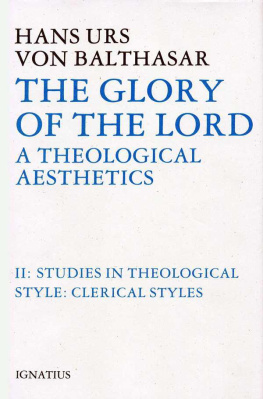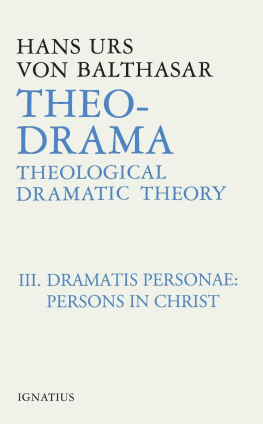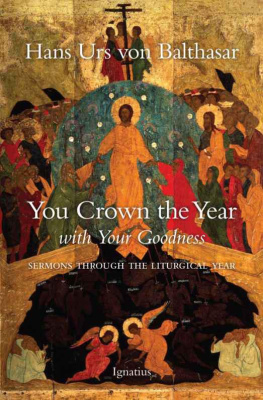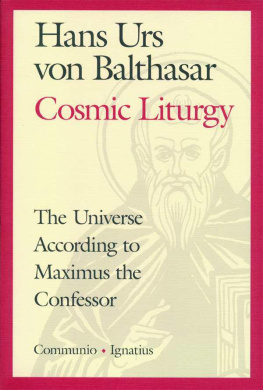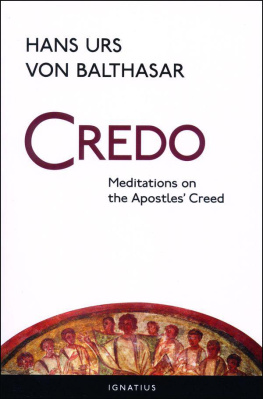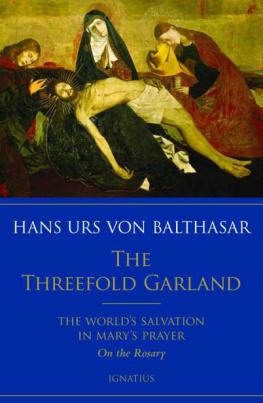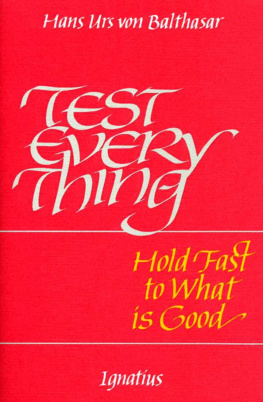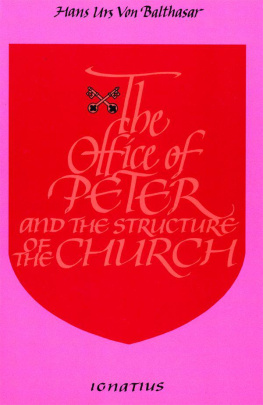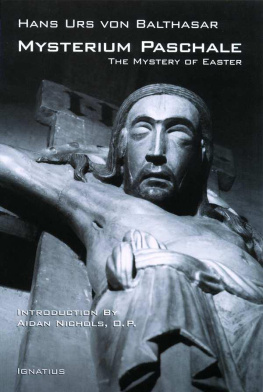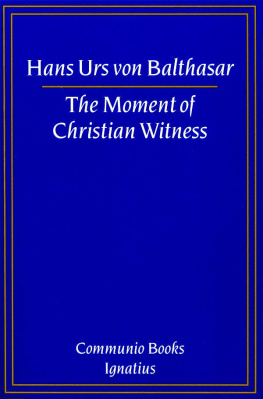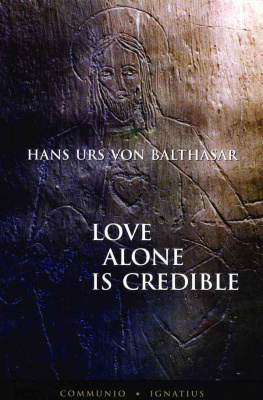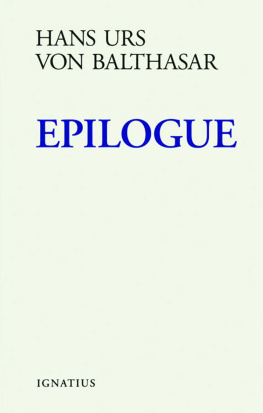THE GLORY OF THE LORD
Hans Urs von Balthasar
THE GLORY OF THE LORD:
A THEOLOGICAL AESTHETICS
By Hans Urs von Balthasar
VOLUMES OF THE COMPLETE WORK
Edited by Joseph Fessio, S.J., and John Riches
1. SEEING THE FORM
2. STUDIES IN THEOLOGICAL STYLE: CLERICAL STYLES
3. STUDIES IN THEOLOGICAL STYLE: LAY STYLES
4. THE REALM OF METAPHYSICS IN ANTIQUITY
5. THE REALM OF METAPHYSICS IN THE MODERN AGE
6. THEOLOGY: THE OLD COVENANT
7. THEOLOGY: THE NEW COVENANT
The publishers gratefully acknowledge the support of the
Pro Helvetia Foundation in the preparation of
the English translation .
THE GLORY
OF THE LORD
A THEOLOGICAL AESTHETICS
BY
HANS URS VON BALTHASAR
VOLUME II:
STUDIES IN THEOLOGICAL STYLE:
CLERICAL STYLES
Translated by Andrew Louth, Francis McDonagh
and Brian McNeil C.R.V.
Edited by John Riches
IGNATIUS PRESS SAN FRANCISCO
Authorised English translation T&T Clark Ltd, 1984
Originally published under the title
Herrlichkeit: Eine theologische Asthetik , II: Fcher der Stile , I: Klerikale Stile
by Johannes Verlag, Einsiedeln, 1962, second edition 1969.
First published in Great Britain by T&T Clark Ltd, 1984,
in association with Ignatius Press, San Francisco, USA.
Latest impression 2006
All rights reserved. No part of this publication may be reproduced,
stored in a retrieval system, or transmitted, in any form or by any means,
electronic, mechanical, photocopying, recording or otherwise,
without the prior permission of T&T Clark Ltd.
Library of Congress Cataloging in Publication Data
Balthasar, Hans Urs von, 1905
Studies in theological style.
(The Glory of the Lor...ans Urs von Balthasar; v. 2- )
Translation of: Fcher der Stile .
Contents: 1. Clerical styles.
1. TheologyMethodology. 2. Theology, Doctrinal.
I. Title. II. Series: Balthasar, Hans Urs von, 1905
Herrlichkeit. English; v. 2, etc.
BT78.B2613 1984 vol. 2, etc. 230s 84-1766.
[BR118] [230]
ISBN 978-0-8987-048-0
Printed in the United States of America
CONTENTS
VOLUME II
STUDIES IN THEOLOGICAL STYLE:
CLERICAL STYLES
Qui tantis rerum creaturarum splendoribus non illustratur caecus est; qui tantis clamoribus non evigilat surdus est; qui ex omnibus his effecibus Deum non laudat mutus est; qui ex tantis indiciis primum principium non advertit stuitus est.
BONAVENTURA
The Church, which was once the mother of poets no less than of saints, during the last two centuries has relinquished to aliens the chief glories of poetry... , she has retained the palm, but forgone the laure.... Fathers of the Church (we would say), pastors of the Church, pious laics of the Church; you are taking from its walls the panoply of Aquinas; take also from its walls the psaltery of Alighieri. Unrol the precedents of the Churchs past; recall in your minds that Francis of Assisi was among the precursors of Dante, that sworn to poverty he forswore non Beauty, but discerned through the lamp Beauty the Light God... What you theoretically know vividly realize: that with many the religion of beauty must always be a passion and a power, that it is only evil when divorced from the worship of the Primal Beauty.
FRANCIS THOMPSON
INTRODUCTION
1. THE CONCERN
The first volume attempted to show that one both can and must consider the revelation of the living God, as the Christian understands it, not only from the point of view of its truth and goodness, but also from that of its ineffable beauty. If everything in the world that is fine and beautiful is epiphaneia , the radiance and splendour which breaks forth in expressive form from a veiled and yet mighty depth of being, then the event of the self-revelation of the hidden, the utterly free and sovereign God in the forms of this world, in word and history, and finally in the human form itself, will itself form an analogy to that worldly beauty however far it outstrips it. In Jesus Christ, to whom the revelation in creation and history leads, the yet greater unlikeness of God over against all that is not divine is not simply inferred as it were from certain signs, nor simply known (in a docta ignorantia ), butno matter how strange the manner of its appearingread off from the form of the revelation and from nowhere else. Where God freely manifests himself (be he still never so deeply veiled), this is finally intended as a gift, as love and therewith as self-surrender; each via negativa which philosophically considered may be set over the via positiva stands in the service of a positive way, indeed the negating ineffability of the gift speaks only of the still greater overwhelming of man ( via eminentiae ) through this ineffable fact that God wills to be with me, for me and in me. This now, in theological terms, is the dazzling darkness of the divine beauty: it is not that which remains inaccessible when God has manifested himself in Christ, rather it is on the contrary the splendour which breaks forth from this love of God which gives itself without remainder and is poured forth in the form of worldly powerlessness: the superabundant power of the light and meaning of love, as it shines forth in the form, causes it to become necessarily a form of veilingjust because it reveals that which is utmost, the ineffable.
If it is true that the divine revelation of grace perfects created naturesboth conferring on the complementary disclosures of beings their final meaning, and also revealing the transparence of all being in the world to the absolute ground of beingthen everything of beauty found in the world (and with it too the true and the good) is drawn up into a relationship to this inexhaustible standard, where the living God of love is glorified as he pours out his limitless love for the creature kenotically into the void which is empty of himself, indeed into what is strictly totally other than himself: into the abyss of guilty, godless darkness and godforsakenness. Thus, going to the utmost point of what is not God, he can finally establish his lordship and his glory in what is other than himself, in man, and by the glorified Kyrios fashion glory out of humanity and the cosmos, which Christ in his final prayer (Jn 17) declares to have been accomplished, at the same time as he still requires it to be accomplished.
This form stands at the centre of the first volume. Everything else is arranged around it: the subjective possibilities of its being discerned; the demonstration of the objective structure of its form (whose cipher could be broken only in terms of the divine, namely as representation of the trinitarian God) and of the glory of God which breaks forth from it objectively, and which is represented in the form of Jesus; finally the whole historical economy, in which this final form is led up to (Old Testament), and which subsequently shows itself in humanity as the Lord of Glory (the time of the Church).
In all this we may gain a preliminary sighting of the relations between the present theological aesthetic and the projected theological dramatic which will follow this work: if God represents himself in the world, then there lies in that an act of the most sublime freedom, an act moreover which is greatly rich in its consequences for human action. Gods advent as Lord of the world and its history can release only the most prodigious drama, which indeed it already contains within itself; there can be here no question of simply perceiving, contemplating, of simply registering what is shown; whoever is moved in faith must go out on the stage ( theatrizesthai : Heb 10.33, cf . 1 Cor 4.9), in the sight of a world which at first imagines it can afford to be nothing more than a spectator itself. The Christian epiphaneia of God has nothing about it of the simple radiance of the Platonic sun of the good; it is an act in which God utterly freely makes himself present as he commits to the fray the last divine and human depths and ventures of love: the ethical is realised precisely in the figure of the aesthetic: behind the perfection of each word, each gesture, each encounter of the Son of Man there stands, making it possible and bearing it, the harmony of divine and human existence, life together with death, heaven together with hell. And again within all thisand not as it were merely as a detached witnessthere lies as the object of a theological logic the structure of the truth, which can indeed be nothing other than the discernment of being in the freedom of its self-revelation.
Next page
